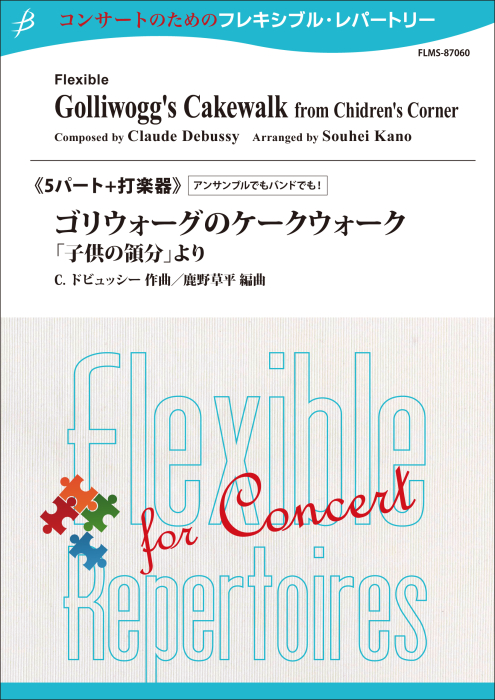Nous utilisons des cookies pour améliorer votre expérience utilisateur. Pour se conformer à la nouvelle directive concernant la vie privée, nous devons vous demander votre consentement pour définir des cookies. En savoir plus.
<< Retour à l'aperçu

Golliwogg's Cakewalk - from "Children's Corner" - Flexible Ensemble/Band

Partitions pour ensemble flexible, 5-voix + percussion optionnelle.
| Article no.: | BRFLMS87060 |
|---|---|
| Compositeur: | Claude Debussy |
| Arrangeur: | Sohei Kano |
| Niveau: | 3½ |
| Durée: | 3:00 |
| Editeur: | Brain Music |
| Format: | A4 21x29,7cm |
Disponible dans ces catégories
À partir de
60,00 €
TTC
Disponibilité :
En stockExpédié :
Sous 1 jour ouvrableGolliwogg's Cakewalk is the final piece in Claude Debussy's six-movement suite for piano entitled Children's Corner (1908). It was influenced by African culture popular at the time in Paris.
Cakewalk is a 2/4 time jaunty dance step from the American South. In the early 20th century, it was also performed at the black dance halls in Montparnasse district, drawing the attention of European artists. Cakewalk music, from the mid-19th century, combined polyrhythm, syncopation, and habanera rhythm with a regular march two-step, and is considered to be influential in the development of American jazz.
This is a flexible ensemble instrumentation arrangement. The number of performers and instruments should be modified throughout the piece according to melodic and dynamic requirements. This adjustment in instrumentation will help achieve the wider dynamic ranges of pp to ff. It is suggested that the ensemble personalize the orchestration by creating extra solo, tutti woodwind and brass sections, using brass only on the accents.
(Sohei Kano)
Cakewalk is a 2/4 time jaunty dance step from the American South. In the early 20th century, it was also performed at the black dance halls in Montparnasse district, drawing the attention of European artists. Cakewalk music, from the mid-19th century, combined polyrhythm, syncopation, and habanera rhythm with a regular march two-step, and is considered to be influential in the development of American jazz.
This is a flexible ensemble instrumentation arrangement. The number of performers and instruments should be modified throughout the piece according to melodic and dynamic requirements. This adjustment in instrumentation will help achieve the wider dynamic ranges of pp to ff. It is suggested that the ensemble personalize the orchestration by creating extra solo, tutti woodwind and brass sections, using brass only on the accents.
(Sohei Kano)
Flexible Band,FLMS-87060,FLMS-87060A,BRFLMS87060S,BRFLMS87060A
 Français
Français Nederlands
Nederlands  English
English  Deutsch
Deutsch 
